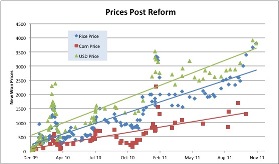Marcus Noland has crunched some numbers to some up with an approximate inflation rate for the DPRK won after it was renominated in November 2009. According to his post:
The chart above shows the trajectory of prices for rice, corn, and the US dollar since January 2010 (i.e. after the huge step-jump in real prices in December 2009 following the currency reform). A simple regression of the prices (technically their logarithmic values) against time suggests that since the beginning of 2010, inflation on an annualized basis has averaged 131 percent for rice and 138 percent for corn. The won has depreciated against the dollar at a 136 percent annualized rate. A monthly breakdown of price movements suggests that while remaining high, the rate of inflation has attenuated, declining in 2011 relative to 2010.
The co-movement of the blackmarket exchange rate and grain prices would be consistent with a small, open economy in which prices are roughly constant in hard currency terms, but are skyrocketing in terms of the rapidly depreciating domestic currency. In the extreme this could depict an economy that was effectively becoming dollarized.
He also refers to a recent report that prices have not fallen with the autumn harvest and that that the DPRK had suspended anthracite coal exports to China out of fear of domestic shortages.
In general I think the findings are plausible and I am glad that this number is finally out there for the public to reference. I have just a couple of additional points of inquiry….
If the price and exchange rate data are from public sources, then they are probably geographically concentrated in the provinces that border China. Since there are significant barriers to arbitrage in the DPRK, I expect a large degree of regional price differentiation. Hypothetically, what would be the effect on these findings of an increase in observations from the “southern” provinces (if that were possible)? If the data are not geographically concentrated and represent a national sample, what would we expect to see if these regressions were run for each province, and how would they compare to the aggregated findings?
A working paper in the making?
UPDATE: A comment from an individual who works with Mr. Noland:
Thanks for sharing this piece on post currency reform inflation. You raise some good points on the regionality of our pricing data. It is true that we don’t have a lot of observations from southern provinces, but it is not all northern either. We get our price data from a number of sources including, but not limited to, Daily NK Market Trends, NK Today reports, and various NGO publications. This gives us a good mixture of general country level price data as well as regional data from provinces such as Pyongyang, North & South Hamyung, North & South Pyongan, & Yanggang. Before the currency reform, we also had a good number of observation from southern areas including North Hwanghae & Gangwon.
Marcus Noland and Stephan Haggard analyzed regional price differences in a previous paper, as well as discussing other issues such as the possible tendency to increase data collection during times of distress and the possibility that organizations might cherry-pick the data that they release, all of which could affect the statistical analysis of this data.
Their analysis found that regional price differences are less systematic than one might expect.
On a related note, Ask a Korean also recently translated another Korean article by Ju Song-ha which deals with food prices in the DPRK. You must read it.


Thanks for sharing this piece on post currency reform inflation. You raise some good points on the regionality of our pricing data. It is true that we don’t have a lot of observations from southern provinces, but it is not all northern either. We get our price data from a number of sources including, but not limited to, Daily NK Market Trends, NK Today reports, and various NGO publications. This gives us a good mixture of general country level price data as well as regional data from provinces such as Pyongyang, North & South Hamyung, North & South Pyongan, & Yanggang. Before the currency reform, we also had a good number of observation from southern areas including North Hwanghae & Gangwon.
Marcus Noland and Stephan Haggard actually analyzed the prospect of regional price differences in a previous paper.
http://www.petersoninstitute.org/publications/wp/wp08-9.pdf. Their analysis found far less differences than one might expect.